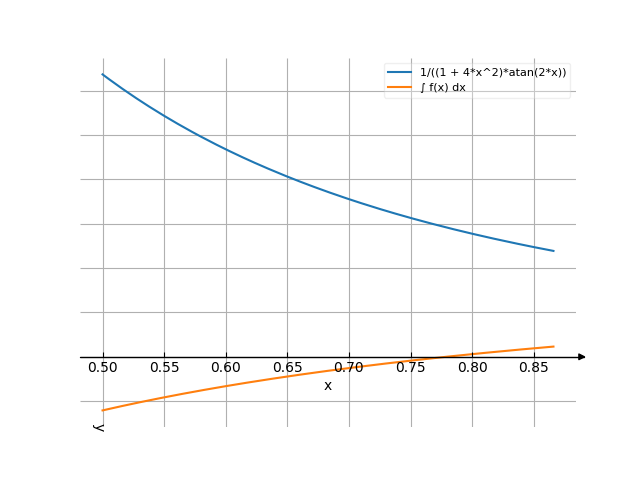Integral of 1/((1+4x^2)*arctg(2x)) dx
The solution
You have entered
[src]
1/2 / | | 1 | 1*-------------------- dx | / 2\ | \1 + 4*x /*atan(2*x) | / ___ \/ 3 ----- 2
Integral(1/((1 + 4*x^2)*atan(2*x)), (x, sqrt(3)/2, 1/2))
Detail solution
-
Add the constant of integration:
TrigSubstitutionRule(theta=_theta, func=tan(_theta)/2, rewritten=1/(2*atan(tan(_theta))), substep=ConstantTimesRule(constant=1/2, other=1/atan(tan(_theta)), substep=URule(u_var=_u, u_func=atan(tan(_theta)), constant=1, substep=ReciprocalRule(func=_u, context=1/_u, symbol=_u), context=1/atan(tan(_theta)), symbol=_theta), context=1/(2*atan(tan(_theta))), symbol=_theta), restriction=True, context=1/((4*x**2 + 1)*atan(2*x)), symbol=x)
The answer is:
The answer (Indefinite)
[src]
/ | | 1 log(atan(2*x)) | 1*-------------------- dx = C + -------------- | / 2\ 2 | \1 + 4*x /*atan(2*x) | /
The answer
[src]
/pi\ /pi\ log|--| log|--| \4 / \3 / ------- - ------- 2 2
=
=
/pi\ /pi\ log|--| log|--| \4 / \3 / ------- - ------- 2 2
The graph

Use the examples entering the upper and lower limits of integration.

![Find the integral of y = f(x) = 1/((1+4x²)*arctg(2x)) dx (1 divide by ((1 plus 4x squared) multiply by arctg(2x))) - with detailed solution [THERE'S THE ANSWER!] 1/((1+4x^2)*arctg(2x))](/media/krcore-image-pods/176/hash/indefinite/0/17/d69aa78fa8e870231737d766f9f6b.png)
 Integral of x^(4/5)
Integral of x^(4/5)
 Integral of sin^2(x)/cos^2(x)
Integral of sin^2(x)/cos^2(x)